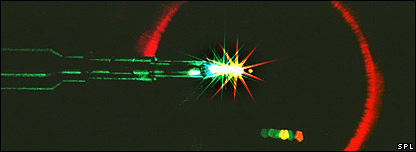Today, the beams of light are ubiquitous, crammed into everything from CD players and phone networks to supermarket checkouts and research laboratories. They have found many problems to solve.
But if an international team led by UK scientists gets its way, lasers could soon face their biggest challenge yet: solving the world's energy crisis in an environmentally friendly way.
Researchers from the Rutherford Appleton Laboratory (RAL) in Oxfordshire, working with partners from 14 countries, have tabled a proposal to use lasers to recreate the physical reactions at the heart of the Sun.
In just one cubic kilometre of seawater there is the equivalent energy of the world's oil reserves
Mike Dunne
Harnessing nuclear fusion, as the process is known, would offer almost unlimited energy without the release of greenhouse gases such as carbon dioxide.
A proposal to fund the set-up costs of a project called Hiper (High Power Laser Energy Research) is currently being considered by the EU.
If the team gets the 50m Euros (£35m) it is asking for to kick-start the project, it would put the researchers on a path that could eventually see an 800m-euro (£500m) working demonstration reactor opened towards the end of the next decade, and commercial reactors soon after that.
"This is not an immediate solution to the world's energy demand," admits Professor Mike Dunne, director of the project at RAL. "But if we're very aggressive you could have a power reactor on the ground by 2030.

